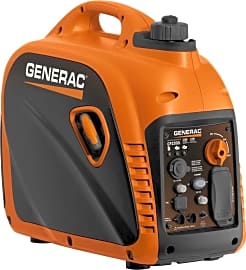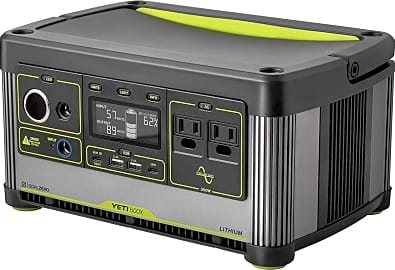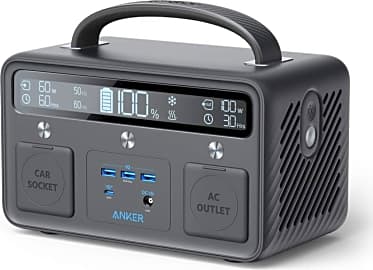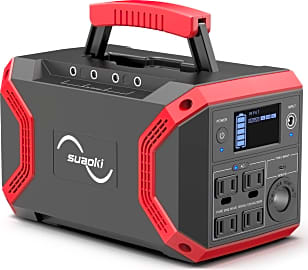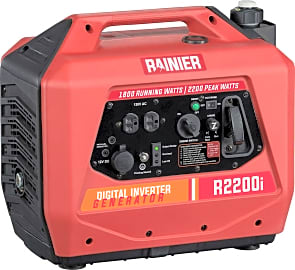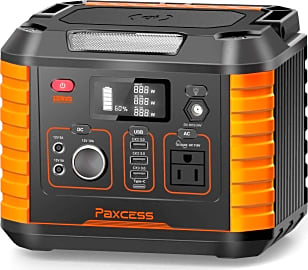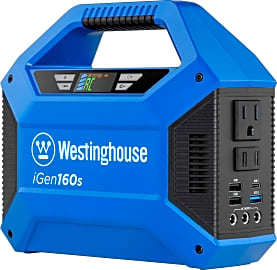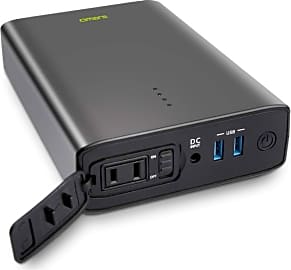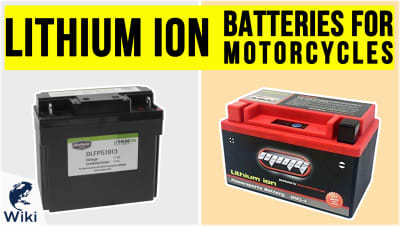The 10 Best Portable AC Power Supplies

This wiki has been updated 38 times since it was first published in November of 2016. If you plan on spending time away from a mains outlet, but you still want the convenience of using all your electrical devices, then check out these portable ac power supplies. We’ve included a variety of picks, from handheld battery packs for charging a laptop or cell phone to generator-sized appliances that are ideal for long trips to the wilderness or tailgating before a big game. When users buy our independently chosen editorial picks, we may earn commissions to help fund the Wiki.
Editor's Notes
November 11, 2020:
Four new models come on board today, including the Goal Zero Yeti 500X, a versatile 500-watt choice that can be charged either through a standard wall outlet or via a solar panel. Like many on our list, it’s equipped with a pure sine wave inverter to ensure smooth running of your devices. It weighs just shy of 13 pounds and is kept lightweight thanks to its lithium ion battery. It’s equipped with a comprehensive LCD to keep you apprised of its status, as well as an ergonomic carrying handle and four sturdy feet for stability. You can buy it with confidence, thanks to its two-year warranty. If you don’t need quite as much power, consider the 300-watt Anker PowerHouse II, which can be hooked up to eight devices at a time and also features a pure sine wave inverter. Like most, it allows for passthrough charging, so it can be charging and provide power to things at the same time. It’s lightweight at just 10 pounds and easy to carry with the top handle.
Another 300-watt option is the newly added Suaoki 300W, which runs efficiently and stays cool thanks to an integrated fan, and it’s got built-in emergency lights to give you peace of mind. In addition, its battery management system helps keep the voltage, current, and temperature within safe ranges so that no harm comes to your electronics. For a budget-friendly, lower-power selection, look to the 100-watt Westinghouse iGen160s, which is lightweight and easy to carry and store, safeguards against overloads, and incorporates a handy flashlight. One caveat is that it’s got a modified sine wave inverter, which are known for their choppy currents that produce electrical noise and cause some devices to run inefficiently. Leaving the list are the Polaroid PS600, the Prymax Portable Station, and the Jackery 85W, all of which have been discontinued.
For safety’s sake, never use a gas-powered generator, such as the Generac 7117 and the Rainier R2200i, inside your home or in a closed garage, since the fumes could be dangerous indoors. Whether you go with a gas- or electricity-run power supply, be sure that it provides protection from problems like short circuits and dangerously low and high voltage. Always read the product manual carefully to ensure you are using it properly.
December 01, 2019:
This category was in need of serious update and only 3 models from the previous list remain – the Chargetech 85W Battery Pack, the Schumacher SJ1332 and the Polaroid PS600.
There are 2 primary types of power an ac supply can deliver: starting power and running power. Starting power (peak or surge power) is higher and can accommodate certain products that need an initial power boost to start running – refrigerators, washing machines, blenders, etc. – while running power is the amount of continuous power your appliances need to work under normal load. Your ideal portable power supply will be based on the activities you intend to use it for, and will take into account the highest starting power plus the collective running power of all your items: Starting Watts Needed = Total Running Watts of All Appliances + Starting Watts of Appliance with the Highest Starting Watts.
It’s important that you check the power requirements of your devices before buying. With that in mind, I wanted to highlight a variety of generators to suit a variety of needs and applications - there’s no point in you buying a massive Jackery 500W (or worse still, a Rainier R2200i) when all you need to do is recharge your laptop now and again during the work day; conversely, the Omars Handheld is not going to be able to handle your power needs during a tailgate party or a 2-day camping trip!
Ultimately, there is a wide array of portable ac power supplies available, sort of on a continuum of power delivery; but for our purposes, I split my selections into 3 broad classes.
For (class 1) lightweight portable ac supplies, I prioritized portability (weight, size) first, followed by price and total capacity (energy output) in mAh or Wh (Ah x V). These models are great to keep around with you in your bag in case you need to recharge your laptop, cell phone or other small electronics in an emergency: Jackery 85W (84Wh(23200mAh), 85W, 100Wp), Omars Handheld (88Wh(24000mAh), 80W, 120Wp), Chargetech 85W Battery Pack(320Wh(27000mAh), 65W, N/A).
While I’ve also listed the peak (surge) power of each of these models (Wp), laptops, phones and similar electronic devices do not usually have surge power ratings, so the Wp value can generally be ignored. While both these models delivered around the same amount of energy as their competitors, they were also cheaper and more reliable than similar models. For instance, the Omars Handheld is about half the price of the RAVPower 27000mAh, while the Jackery is much smaller and lighter than the same model. Both these models are also suitable as flight carry-ons as they fall under the Federal Aviation Administration’s Safe Limit of 100Wh.
Where with the lightweight classification, portability took precedence over many other considerations, with (class 2) middleweight portable ac supplies, I wanted to prioritize the return on investment (i.e. bang-for-buck). I did this by inspecting the cost per unit of energy of many devices (by dividing the total energy in Wh by the price). I also looked at the average and peak powers among quality factors (ease of use, weight, common issues, etc.), with more weight on the average power, since these models will likely be used for devices with no starting power requirements.
I’ve included the following in ascending order of capacity: Paxcess 330-Watt Generator (288.6Wh, 330W, 700Wp), Prymax Portable Power Station (298Wh, 300W, 600Wp), Jackery 500W (518Wh, 500W, 1000Wp), Polaroid PS600 (578Wh, 300W, N/A).
The Polaroid PS600 (one of the few remaining models from before the update) still delivers the lowest cost per unit of energy, while the other models I’ve included are also good in this regard. I had to remove a lot of the older models because they delivered comparatively poorly on the cost-per-unit-energy metric. I also disregarded a lot of new and otherwise good models for the same reason (like the Jackery 200W and Rockpals 300W).
Among models in this class that I removed was the Goal Zero Yeti 400 Solar, which, despite being designed with the noble intention of providing a zero-emissions alternative to wall-socket rechargeable models by using solar panels, was not the best option on the cost-per-unit-energy scale – at 29 pounds, it was also an insanely heavy model for the capacity it offered.
Now, while ac power supplies have generally not included gas-powered generators (since they have been so large in the past), the prevailing trend in recent years has been towards building smaller and more compact portable generators that weigh around 40 pounds and were designed to be carried around and stored in the back of your car for an emergency or for certain outdoor recreational activities like longer camping trips or tailgating. Technically, these portable generators are also portable ac supplies, since they supply ac current.
These generators are significantly more cost effective than electrically chargeable power supplies -- you end up getting far greater capacity compared to smaller wall-charging units, and gas is cheaper too -- and it would be inaccurate not to account for the best models here, since these are indeed classified as portable ac supplies.
I refer to these as (class 3) heavyweight or heavy-use portable ac supplies, and while they can be a little noisier and larger than smaller battery-run models, they are still significantly quieter and lighter than larger generators and produce a more consistent sine wave power output than jobsite generators. In fact, unless you have a very specific purpose for a small model and you’re not looking for a portable ac supply for overall emergency power backup needs, then I would personally recommend investing in one of these larger machines, which is why I’ve included both these models higher up in the rankings. In addition to noise levels and weight, a good warranty is an important consideration with these models since they are a slightly larger investment. I’ve included two excellent and budget-friendly options: Rainier R2200i (12.6KWh, 1800W, 2200Wp), Generac 7117 GP2200i (4.95KWh, 1800W, 2200Wp).
These are both great, reliable models with warranties and optional protection plans that are always good to consider with such an investment. While the Honda EU2200i is a great overall competitor on the market by our standards, these models are very close to its standards and significantly more affordable - which, ironically, makes them better options than the Honda by our considerations.
The one model I haven’t mentioned is the Schumacher SJ1332 which is really designed as a car jump starter and not a spare electronics power supply – hence its very high peak power. In terms of capacity, this model would fit between the lightweight and middleweight classes, though it has a different function to most other picks, so I thought it best to keep it in the list for the sake of range as well as mention it separately here.
Take The Power Back
When it comes to literal cases of powerlessness, the last thing you want to do is leave the acquisition of power to chance.
Powerlessness is an agonizing feeling. If you’ve ever had your car towed, you know a thing or two about how powerlessness feels. I once had my car impounded due to a communication error between the state to which I had moved and the state in which my car was financed. Neither DMV claimed to have the title, and both told me I had to get it from the other one. If not for a stroke of luck involving an old roommate and a mistakenly released title some years prior, I might have had to take legal action, all the while living in Los Angeles without a car (the equivalent of living in New York City without any legs).
When it comes to literal cases of powerlessness, the last thing you want to do is leave the acquisition of power to chance. When you need juice for your devices — whether you’re on the road or in the wilderness, or the power in your town or city has been out for a while — every second can count. We’ve seen a variety of emergency situations in recent years, from floods and earthquakes to wild fires, in which power grids were put in danger in the best cases, and utterly destroyed in the worst.
In an emergency situation, you’ll take your power from wherever you can get it, and old-fashioned, gas-powered generators are a reliable option if you happen to have access to gasoline. If you don’t have a store of reliable gas in your garage or camping backpack, and all the local pumps (which are now, quite stupidly, electronically controlled) are empty or out of service, you’ll need another source of power. That’s where a portable AC power supply can be a dream.
Compared to gas generators, which create power from scratch by the combustion of gasoline, portable AC power supplies charge up like giant batteries and provide a ton of power to anything with a traditional plug. Many also provide DC conversion, as well as USB and other common plugs to power a more significant number of devices. They’re smaller, lighter, and more versatile than gas generators, as well.
When To Use Portable AC Power Over A Gas Generator
None of the above is to say that gas generators have no place in your life. Quite the opposite is true. A thorough emergency plan will include both forms of power for a number of reasons. Gas generators can create far more power than most AC power supplies can store, making them the better choice when gas is readily available and you need as much power as possible for an undefined period of time. If you have a better defined energy need that falls within the charge capacity of an AC power supply, however, it is the best possible choice.
A thorough emergency plan will include both forms of power for a number of reasons.
For example, many film sets have for years relied on gas powered generators to run lights and other equipment on location. Traditional movie lights draw a ton of power, so this was a good solution, but the noise they created was awful. Most productions found that they had to place their generators far away from the shooting location and isolate them in custom-built enclosures to try to cut down on the sound. Fortunately for today’s independent filmmakers, LED lights can perform as well, if not better in many cases, than traditional film lights, and they require so little energy that they marry perfectly with a portable AC power supply. These units run in complete silence, are incredibly lightweight and easy to set up, pose no fire or explosion risk on set, and can keep a pair of LED lights running for hours on a single charge.
If you do a lot of camping in cabins or tents without power, a portable AC power supply can provide you just the right amount of juice in the wild. Obviously, you head into the wilderness to escape the hum of the grid, but a little power can provide enough light to keep yourself safe, as well as warmth through small electric heaters if the temperature unexpectedly drops. Campers are also among the greenest people around, and they’ll be pleased to learn that many portable AC units can charge via solar panels, operating end-to-end with zero carbon footprint.
Some portable AC power supplies can also combine their peak power output with a pair of jumper cables to provide your car with a much-needed jumpstart if its battery ever fails. Since they don’t store gas or any other volatile chemicals that could leak or burst into flames, these units can safely live in your trunk or back seat.
How To Choose Your Portable AC Power Supply
Given the array of portable AC power supply units on the market, you might need a little assistance figuring out which of the models on our list is right for you. The most important thing you can do to narrow down our list to fit your needs is to assess what you want to plug into your AC unit.
Very simply put, the bigger this number, the more a juice a unit can hold.
If you merely want a little extra power for your phone and tablet while spending a weekend at the beach or in the woods, then a slightly smaller unit should suffice. If you need to power devices with a more consistent draw, you’ll want a bigger unit.
But what makes a unit large or small? It has less to do with physical dimensions, and more to do with capacity as measured in milliamps per hour, or mAh. Very simply put, the bigger this number, the more a juice a unit can hold.
Another important consideration is the decision whether or not to go solar. If you classify yourself as a prepper, or you know you spend extended periods off the grid, the ability to recharge your supply with nothing more than the power of the sun is exceptional, indeed. Just be aware that solar panels are often sold separately, and unless you’re willing to pay a pretty penny, AC units that can charge via solar power often store less juice.


